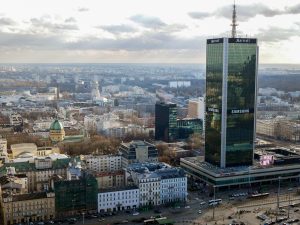Scaling green hydrogen technology for the future
Thyssenkrupp nucera has entered into a strategic partnership with the renowned German research institute Fraunhofer IKTS to move the technology toward applications in industrial manufacturing. The company envisages SOEC as a complement to AWE in the areas where it is cost effective to reduce overall energy consumption. “The combination of AWE and SOEC in thyssenkrupp nucera’s portfolio offers a unique product suite to the industry,” says Noeres.
While advancements in electrolysis technology and the diversification of its applications across various scales and industries are promising for green hydrogen production, a coordinated global ramp-up of renewable energy sources and clean power grids is also crucial. Although AWE electrolyzers are ready for deployment in large-scale, centralized green hydrogen production facilities, these must be integrated with renewable energy sources to truly harness their potential.
Making the green hydrogen market
Storage and transportation remain obstacles to a larger market for green hydrogen. While hydrogen can be compressed and stored, its low density presents a practical challenge. The volume of hydrogen is nearly four times greater than that of natural gas, and storage requires either ultra-high compression or costly refrigeration. Overcoming the economic and technical hurdles of high-volume hydrogen storage and transport will be critical to its potential as an exportable energy carrier.
In 2024, several high-profile green hydrogen projects launched in the U.S., advancing the growth of green hydrogen infrastructure and technology. The landmark Inflation Reduction Act (IRA) provides tax credits and government incentives for producing clean hydrogen and the renewable electricity used in its production. In October 2023, the Biden administration announced $7 billion for the country’s first clean hydrogen hubs, and the U.S. Department of Energy further allocated $750 million for 52 projects across 24 states to dramatically reduce the cost of clean hydrogen and establish American leadership in the industry. The potential economic impact from the IRA legislation is substantial: thyssenkrupp nucera expects the IRA to double or triple the U.S. green hydrogen market size.
“The IRA was a wake-up call for Europe, setting a benchmark for all the other countries on how to support the green hydrogen industry in this startup phase,” says Noeres. Germany’s H2Global scheme was one of the first European efforts to facilitate hydrogen imports with the help of subsidies, and it has since been followed up by the European Hydrogen Bank, which provided €720 million for green hydrogen projects in its pilot auction. “However, more investment is needed to push the green hydrogen industry forward,” says Noeres.
In the current green hydrogen market, China has installed more renewable power than any other country. With lower capital expenditure costs, China produces 40% of the world’s electrolyzers. Additionally, state-owned firms have pledged to build an extensive 6,000-kilometer network of pipelines for green hydrogen transportation by 2050.
Coordinated investment and supportive policies are crucial to ensure attractive incentives that can bring green hydrogen from a niche technology to a scalable solution globally. The Chinese green hydrogen market, along with that of other regions such as the Middle East and North Africa, has advanced significantly, garnering global attention for its competitive edge through large-scale projects. To compete effectively, the EU must create a global level playing field for European technologies through attractive investment incentives that can drive the transition of hydrogen from a niche to a global-scale solution. Supportive policies must be in place to also ensure that green products made with hydrogen, such as steel, are sufficiently incentivized and protected against carbon leakage.
A comprehensive strategy, combining investment incentives, open markets, and protection against market distortions and carbon leakage, is crucial for the EU and other countries to remain competitive in the rapidly evolving global green hydrogen market and achieve a decarbonized energy future. “To advance several gigawatt scale or multi-hundred megawatts projects forward,” says Noeres, “we need significantly more volume globally and comparable funding opportunities to make a real impact on global supply chains.”
This content was produced by Insights, the custom content arm of MIT Technology Review. It was not written by MIT Technology Review’s editorial staff.






